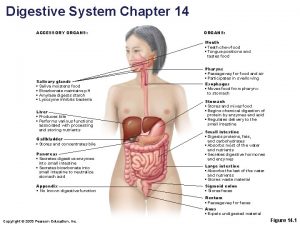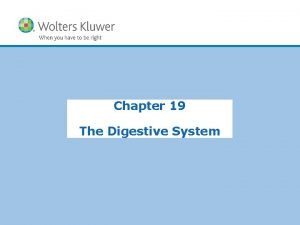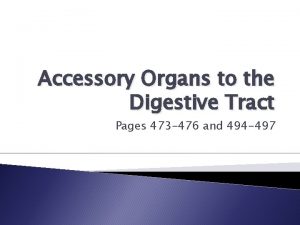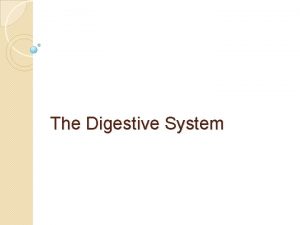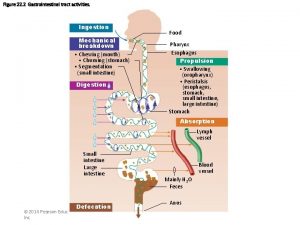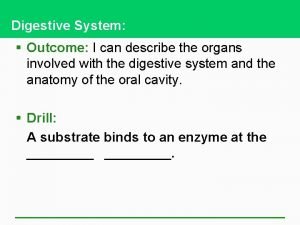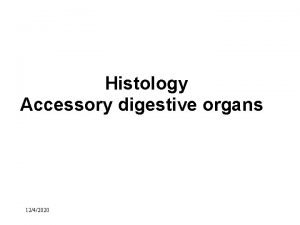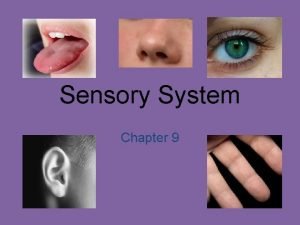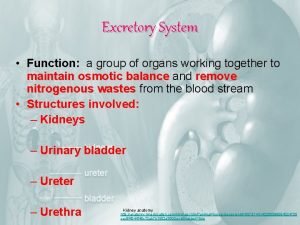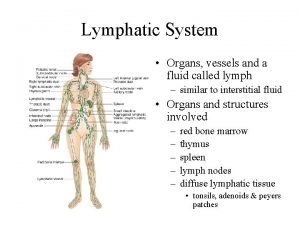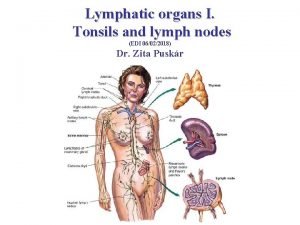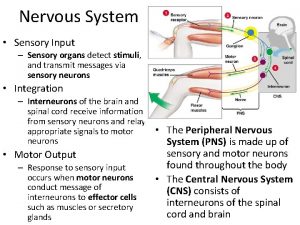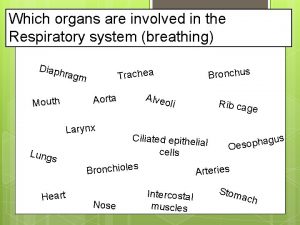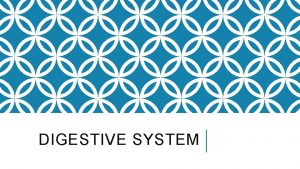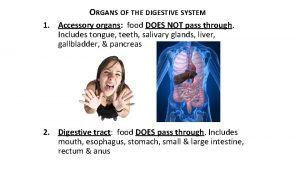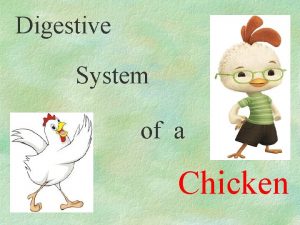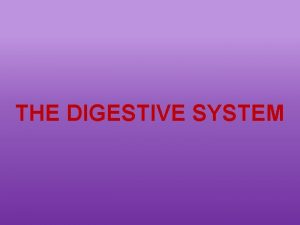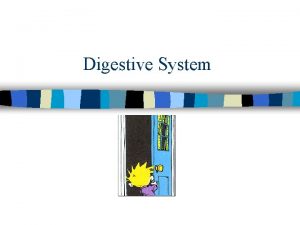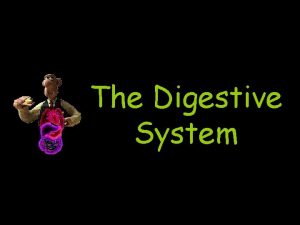The Digestive System Lecture 3 The organs that



























- Slides: 27

The Digestive System Lecture 3


The organs that compose the digestive system digest, absorb and process nutrients taken in as food. Materials not absorbed into the lining of the intestine form the feces and leave the body through the anus. Our study of the digestive system begins at the point where food leaves the mouth and enters the esophagus.

Word Root Esophag ◦ From a Greek word oisophagos, meaning esophagus or gullet. Combining ◦ esophag/o forms

The difference between: -stomy and -tomy -stomy ◦ This means a mouth or opening. ◦ Usually a stoma is formed by surgery, e. g. a colostomy is an opening or the formation of an opening into the colon. ◦ A stoma can be temporary or permanent. -tomy ◦ Means an incision as at the beginning of an operation.

Word Exercise 1 Find the meaning of: A. esophago/scope…………. ◦ Remember that, to understand the meaning of these medical terms, we read the components from the suffix towards the beginning of the word. esophag/ectomy ……………… C. esophago/tomy ………………. . D. esophag/itis …………. . B.

Word Root Gastr ◦ (From a Greek word gaster, meaning stomach. ) Combining ◦ Gastr/o forms

Word Exercise 2 write A. B. C. D. the meaning of: gastro/scope ……………. gastr/ectomy ……………. . gastro/tomy ……………… gastr/itis …………………. .

Word Exercise 2 Build words that mean: disease of the stomach ……………… F. study of the stomach ………………. . G. pertaining to upon/above the stomach …………………. . E. Remember, when building words the combining vowel is usually dropped if the suffix begins with a vowel.

Nasogastric tube A naso gastric tube (nas/o meaning nose) that passes through the nose to the stomach can be used for suction, irrigation or feeding.

Word Root Enter ◦ From a Greek word enteron, meaning intestine or gut. Combining ◦ Enter/o forms

Word Exercise 3 write A. B. C. D. E. the meaning of: enter/itis …………… entero/pathy …………. . entero/tomy …………… entero/stomy ………………. . entero/lith ………………… build words that mean: study of the intestine …………………. G. a person who studies the intestines …………. F.

Word Root Pylor ◦ From a Greek word pylouros, meaning gate-keeper. Combining ◦ Pylor/o Between forms the stomach and the small intestine there is a sphincter muscle known as the pylorus. This acts as a valve which opens periodically to allow digested food to leave the stomach.

Word Exercise 4 write the meaning of: A. pyloro/gastr/ectomy ………………… B. pyloro/scopy …………………

The Small Intestine The small intestine which consists of three parts, ◦ duodenum, concerned mainly with digestion of food ◦ jejunum ◦ and ileum. jejunum and ileum are specially adapted for the absorption of nutrients.

Word Roots Duoden ◦ From a Latin word duodeni, meaning twelve. It refers to the duodenum Combining forms ◦ Duoden/o Jejun ◦ From a Latin word jejunus, meaning empty. It refers to the jejunum, part of the Combining ◦ Jejun/o forms

Word Roots ile ◦ From a Latin word ilia, Combining ◦ ile/o forms

ILEOSTOMY A permanent opening is made when the whole of the large intestine has been removed. This acts as an artificial anus. The ileum opens directly on to the abdominal wall and the liquid discharge from it is collected in a plastic ileostomy bag

The Large Intestine The large intestine has a wider diameter than the small intestine and it is shorter. Its main function is to absorb water from the materials that remain after digestion and eject them from the body as feces during defecation. The large intestine is made up of the cecum, appendix, colon, rectum

Word Roots Cec ◦ From a Latin word caecus meaning Blind. Combining forms ◦ Cec/o Append ◦ From a Latin word appendix, meaning appendage Combining ◦ Append/o forms

Col ◦ From a Greek word kolon, meaning colon, the large bowel extending from caecum to rectum. ) Combining forms ◦ Col/o, colon/o

Word Exercise 6 Find A. B. C. D. the meaning of: mega/colon …………. . appendic/itis ………………. . col/ectomy ………………… colo/stomy …………

build words that mean: E. formation of an opening into the cecum ………………. F. removal of the appendix ……………… G. formation of an opening between the stomach and colon …………………. .

Gallstones (Cholelithiasis) Miss B, a 35 -year-old, presented to her general practitioner complaining of pain emanating from the epigastric and right hypochondrial regions radiating to the back. The pain lasted for about 3 hours following each meal and was accompanied by nausea and occasional vomiting. Her GP's initial diagnosis was biliary colic, and he prescribed an analgesic drug. The pain did not resolve and she was admitted to the gastroenterology unit. Initial ultrasound investigations revealed multiple stones in the gall bladder and a dilated common bile duct.

A date was set for early elective laparoscopic cholecystectomy. Due to her excessive weight, laparoscopy was deemed inappropriate by the surgeon and she was advised of an alternative procedure. An open cholecystectomy was performed and the inflamed gall bladder found to contain three gallstones each approximately 1. 5 cm in diameter. A bile sample was sent for culture and sensitivity testing and a nasogastric tube passed.


Word Help analgesic pain relieving drug culture and sensitivity testing growing microorganisms in the laboratory and testing them for sensitivity to antibiotics dietician/dietitian specialist who plans and advises on diet with the approval of medical staff elective voluntary/not an emergency/at a planned date GP general practitioner (family doctor) hypochondrial the region to the side, just below the intravenous pertaining to within a vein open surgery via an incision (here into the abdomen) peri-operative around the time of operation post-operative pertaining to after/following operation subcutaneous pertaining to under the skin ultrasound using sound waves to produce an image
 Major and accessory organs of the digestive system
Major and accessory organs of the digestive system Accessory organs of the digestive system
Accessory organs of the digestive system Major and accessory organs of the digestive system
Major and accessory organs of the digestive system 4 functions of the stomach
4 functions of the stomach Accessory digestive organs
Accessory digestive organs Internal organs
Internal organs Sinusoids
Sinusoids Digestive respiratory and circulatory system
Digestive respiratory and circulatory system Phân độ lown ngoại tâm thu
Phân độ lown ngoại tâm thu Premature atrial contraction
Premature atrial contraction Thể thơ truyền thống
Thể thơ truyền thống Thơ thất ngôn tứ tuyệt đường luật
Thơ thất ngôn tứ tuyệt đường luật Walmart thất bại ở nhật
Walmart thất bại ở nhật Tìm vết của mặt phẳng
Tìm vết của mặt phẳng Con hãy đưa tay khi thấy người vấp ngã
Con hãy đưa tay khi thấy người vấp ngã Tôn thất thuyết là ai
Tôn thất thuyết là ai Gây tê cơ vuông thắt lưng
Gây tê cơ vuông thắt lưng Sau thất bại ở hồ điển triệt
Sau thất bại ở hồ điển triệt 01:640:244 lecture notes - lecture 15: plat, idah, farad
01:640:244 lecture notes - lecture 15: plat, idah, farad Nervous system and digestive system
Nervous system and digestive system Sensory system organs
Sensory system organs Dissected kidney
Dissected kidney Lymphatic and urinary system
Lymphatic and urinary system Lymphatic system organs
Lymphatic system organs Hemicapsule
Hemicapsule Lymphatic system organs and functions
Lymphatic system organs and functions Organs of the sensory system
Organs of the sensory system Which organs are involved in respiratory system
Which organs are involved in respiratory system
